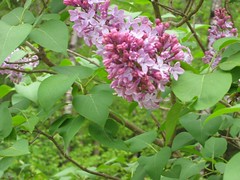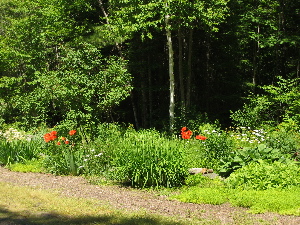PRUNING LILACS
I hope you read my previous post on pruning. It hits all the very basic ideas. However, now your lilacs are about done blooming, and it's time to think about dealing with them specifically. Mine are in full bloom right now. I took this photo just a couple of days ago.
However, when you are done enjoying them, IT WILL BE TIME TO DEAL WITH THEM!
Lilacs bloom on last year’s growth. What this means is that you can prune them right now and all of this years growth should begin to give you bloom either next year or the year following. Buds form in June and July, so you’ve got time to get the job done now.
The object is to have 7 to 10 stems of different ages (or thicknesses). The easiest way to deal with them is to remember that you want the blooms down where you can smell, as well as reach them. So, every year, trim out about a fifth of the branches growing up from the ground. Take out the thickest and the oldest branches first, cutting them as close to the ground as is practical. The reason you do that is because the oldest branches either don’t bloom as well, or they are blooming up SO high that you can neither take cuttings for the table (or to give to friends), or enjoy the wonderful odor they produce! I know it absolutely KILLS you to cut out those lovely tall branches, but believe me you’ll be happier for having done it. The plant will look much better since it won’t be as straggly any longer. It will also bloom much better next year!
If you do this every year after blooming, in about 4-5 years you’ll have a totally rejuvenated bush! ENJOY!
By the way, here’s a book I think should answer all your questions.





